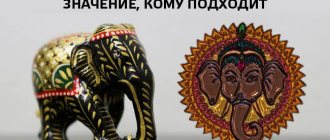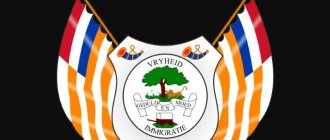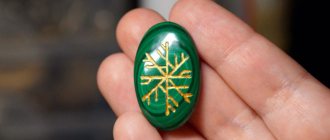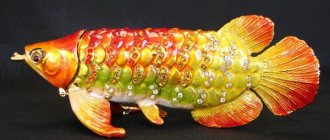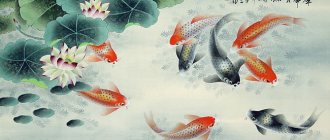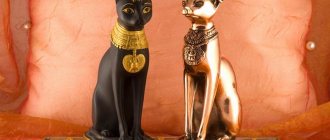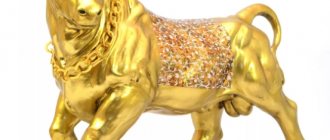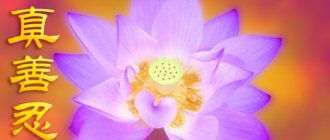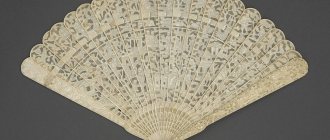A fan is an object that has been used by people since ancient times. But it helps not only in hot weather. According to ancient teachings, a Feng Shui fan also serves as a kind of amulet that can protect its owner, bringing positive energy into his life.
The history of the fan goes back about 2000 years. This item first appeared in China, and at first it was used only by men who did not part with the talisman even during battles. Later, women began to use it to protect themselves from evil influence. To do this, there is no need to carry the amulet with you everywhere; just hang it in your living room or office.
Feng Shui fan: meaning
In the Land of the Rising Sun, a fan is by no means an attribute of a relic of the past and not a banal decoration for the home. The fan can still be found in almost every Chinese home, because it is believed that it is a very powerful amulet, a protector from unkind people, their deeds and their thoughts.
Literally, a fan in Feng Shui can sweep away the evil energy emanating from other people from your home, and protect your home from strife and disputes generated by other people’s influence. The Feng Shui fan (our article will help show you what it means) is a powerful way to control energy flows and their vibrations. By pushing away negative energy on one side, the fan attracts positive energy, restoring balance.
The beneficial energy that the fan literally sweeps into the house can correct not only your affairs in the sphere of career and love, but also improve your health, relieve the blues, depression and chronic fatigue.
Feng Shui experts advise not only placing a Chinese fan on the wall to repel negative vibrations and protect your home, but also fanning yourself with it, that is, using it for its intended purpose. Thanks to this, you will literally immediately be able to feel an influx of new strength and creative calm, and negative energy will leave your body forever.
The meaning of tattoos for men
For a man, a fan tattoo is a sign of strength and high status. An unfolded fan, made in a laconic black and white manner, means expanding the horizons of consciousness, enriching oneself with knowledge and skills. The moving fragments of a small folding fan on a tattoo are personified with a tireless movement forward, a desire to gain new experience, and develop talents.
According to Feng Shui philosophy, a fan can easily ward off negativity and envy, so a small graphic tattoo can serve as a good amulet for a person who has to communicate often and a lot.
Love for girls and flirting with them is symbolized by a tattoo that combines a beautiful female image and an elegant, flirty fan. The wearers of such tattoos, made with realistic precision, are great connoisseurs and connoisseurs of female beauty and grace. Such guys know how to communicate in the language of glances and gestures, they love to play a subtle and exciting love game with fans, in which only body movements and eye expressions tell about feelings.
Fan color
The Golden Feng Shui Fan stands apart from everyone else. He is a symbol of eternal life. According to Chinese legend, an immortal used it to resurrect the dead.
A red fan brings good luck. It is better to hang it at the entrance to the room.
An image on a Feng Shui fan of an eagle or two dragons playing with a pearl will contribute to career advancement.
Cedar on a fan brings and improves health. It should be placed in the east of the house.
Images of all kinds of fish attract the energy of prosperity and well-being. The most common with nine carp. Should be hung in the southeast sector.
A fan of slotus, peacock, peonies or cherry blossoms will help attract love. It is also believed that these images contribute to the birth of an intelligent son. For the southwestern sector.
Cranes, pine trees or bamboo on a fan bring health and longevity. For the east.
A fan with a sailboat or ship will attract success in business and in life in general.
A great decoration for a Feng Shui fan home with high mountains, green trees or blue water. In a word, with images of nature. Charges with energy and gives a good mood throughout the day.
In addition to drawings, Feng Shui fans can also contain hieroglyphs. They can be different depending on what you want to attract into your life (love, health, luck, etc.)
You can hang a fan at work so that it protects you from the negative influence of unkind people and gives you energy in your work. At the workplace, it is better to place the fan behind your back.
Source: vash-fenshyu.ru
In which sector should I place it?
The dragon and phoenix are the main Yin-Yang symbol of Chinese cosmology and mythology.
Phoenix - Yin splendor and feminine beauty when the Phoenix stands next to the Dragon. Together they symbolize harmony, a fruitful marriage, blessed with success, prosperity and children.
- You can place them in the northwestern sector, add good luck favor to the patriarch of the house
- in the southwest sector to bring good luck to the mother at home.
- Dragon and Phoenix in the east will benefit the health of the family,
- while in the south it will bring luck and recognition to everyone living in the house.
Most of us think of the fan as an item that was in fashion many years ago. A picture appears in my head of ladies in beautiful crinoline dresses walking through a green park, discussing social news, fanning themselves along the way. However, in Eastern culture, the fan not only did not lose its popularity, but also acquired a completely different meaning. Feng Shui uses this attribute as a protective agent against malevolent energy.
Fan meaning
Ancient Chinese myths and legends turned the fan into a kind of talisman of life. Taoist Zhong Lio'an possessed immortality and used his golden fan to resurrect the dead. In those days, fans were worn by the very cream of society, so people with this accessory were highly respected. The fan became no less popular when it began to be considered an erotic symbol.
If you are wondering where to hang the fan you purchased, you won’t get a definite answer. It is hung in the sector of the house that needs to be activated. The most popular place to place a talisman is the south side of the home, which is responsible for fame. Locate this area using a compass and decorate it with a fan. By the way, for this zone it is best to choose a talisman with an image of an eagle on it.
To improve the health of the family and protect against diseases, the fan is hung in the eastern side of the house. It should be decorated with cedar or spruce. If you need to improve your financial situation and replenish your piggy bank, buy a fan with the image of one or more fish and decorate your office with it.
Perhaps in some areas of your life you feel discomfort, lack of progress, in a word, stagnation. To activate the love or career zone, place the amulet in the right place.
If your relationship with your spouse is tense, hang a fan by your bed, and after a short period of time you will regain your former harmony, love and passion.
If you feel constant fatigue, a lack of creative ideas and simply an unwillingness to work, you need to hang a talisman behind your back in the place where you work. For example, at a desk in an office. The fan should be positioned in a certain way - at an angle of 45° with the fan turned upward.
The size of the fan depends on the size of the room. Everything should be proportional - a small fan for a small room, a larger fan for a large room. An overly large size of the talisman will not bring a positive result, only excitement, anxiety and worry. A small fan will not give the proper impulse.
Color and images on the fan
You can choose absolutely any shade of the talisman, the only rule is that you like it, relax it and give aesthetic pleasure. However, there are a few tricks that will definitely work. Below we present the most popular options for fans and images on them.
- The golden fan gives vitality, energy in all endeavors and protects from the negative effects of external factors. It also has a positive effect on relationships. It would be good if it was decorated with images of paired figures or hieroglyphs of happiness and love.
- A red fan will bring success and good luck and improve the financial situation of the family. Hang it near the front door of the house.
- Drawings of dragons with pearls or an eagle attract career growth, good luck in business and professional success.
- Cedar protects against diseases, ensuring well-being and health. Should be placed on the east side of the house.
- The fish attracts financial well-being, an influx of money into the house, hang a fan with its image in the southeast. It will be great if you find an attribute with the image of several fish.
- Blooming sakura or lotus are symbols of love and attraction of the opposite sex. Broadcast in the southwestern part of the apartment.
- Peonies or a peacock, according to ancient Chinese legends, contribute to the fact that you will have a smart and intelligent boy. Hang this fan in the south direction.
- Bamboo, pine, cranes - these are pictures for the east of your apartment. They will protect the health of family members and promote longevity.
- The drawing of a ship attracts success in your professional field.
- Images of nature - green meadows, lakes and mountains - relieve fatigue, give a good mood and a positive attitude.
- Hieroglyphs are an alternative to images on fans. Depending on your needs, choose a fan with the hieroglyph of health, love, success, etc.
Facts from history: why the fan is so popular in China
In ancient China, there was a legend according to which the Taoist monk Zhong Lio'an gained eternal life and could bring dead people back to life with the help of his fan. The fan was revered as a symbol of wealth, success, a sign of high society and belonging to it.
In ancient times, the fan was used not only as a mysterious amulet in the practice of Feng Shui, but also as a means of seduction and flirtation. There were whole secret signs and gestures that could indicate to a man that a woman was interested in him. Thus, a fully open fan, leaning close to a woman’s face, and a look from under it symbolized the desire to get to know each other better and flared passion.
The fan in Chinese homes was traditionally hung in the so-called “glory zone,” located in the south of the house. Such a talisman helped to attract success, well-being and prosperity to the home.
The long-standing mythology of mysterious China claims that the all-powerful wind goddess Nemiza brought a fan to earth in order to relieve people from suffering and pain. If a person needed the help of the goddess of the wind, then it was enough to wave a fan, and then the goddess responded to the call of the sufferer, moderating his pain.
The first fans appeared in China two thousand years BC, and they were so huge that they fanned nobles and emperors like fans. Traditionally, fans were used exclusively by men, they even took them with them into battle, and later, thanks to the fan, a whole system of secret signs was developed to transmit encrypted messages.
Later, the fan gained popularity in Japan, and small hand-painted bamboo fans throughout the East were revered by the nobility and aristocrats as an invariable attribute of clothing.
LiveInternetLiveInternet
Quote from TimOlya's message
Read in full In your quotation book or community!
The fan and its symbolism in Europe.
The first fans in Europe imitated imported Chinese and Japanese copies in everything. However, already in the 17th century, its own range of subjects was developed. Italian fans, starting from the 1600s, were decorated with a wide variety of subjects, often depicting paintings by artists of past centuries. The heyday of painted fans occurred during the reigns of Louis XIV and Louis XV. In the 17th century, Chinese and Versailles subjects, flowers, landscapes, Greek myths, gallant and love scenes were common.
During the Baroque era, the fan became a real luxury item. In the 1660s, the “French Guild” for the manufacture of fans flourished and its status as “supplier to the court” was confirmed by the king himself. The French rules were very strict - it was allowed to paint fans with only a limited number of scenes, but in Italy, craftsmen used a wide variety of designs, which often made their products more attractive to the consumer.
At the court of Louis XIV, fans also played a role in the palace ceremony - ladies could open them only in the presence of the queen. A young girl, before appearing in the world (among other sciences), had to learn the art of handling a fan.
A lady with a fan in the Baroque era was certainly an aristocrat: the “third estate” did not have access to this accessory. The fan added significance and importance to the court beauty - she proudly performed at royal receptions and balls, and the fan in her hands looked like a commander’s baton. Over time, the fan turned from a fan and a “symbolic object” of an aristocrat into a real instrument of flirtation
At the beginning of the 18th century, fans depicted pastorals, scenes from the Bible, allegories (both as part of a plot painting and as independent motifs), often scenes reminiscent of paintings by Watteau, Boucher, Fragonard (the execution of the paintings was even attributed to these artists). English fans could depict a court, the rules of the game of whist, “real” scenes of village life (not pastorals), flowers (as on English porcelain of the same time). French fans were often equipped with ingenious mechanisms, for example, they were telescopically retractable, there could be winding mechanisms on the outer ribs; in addition, there were fans with compartments for storing small items.
In the Rococo era, the fan turned into an elegant toy, an instrument of flirtation and thoughtful female coquetry. Moreover, now it has become available to representatives of the bourgeoisie
However, the ability to use a fan correctly was still inherent only to aristocrats. It is not without reason that the famous writer of the turn of the 18th-19th centuries, Germaine de Staël, argued that by the manner of holding a fan one can distinguish “... a princess from a countess, and a marquise from the bourgeoisie.” Now only manners and upbringing could separate representatives of high society from commoners
.
With the advent of fashion for Chinese porcelain and the “chinoiserie” style (lit. “Chinese”), fans began to be painted with scenes from the life of Chinese rulers and their courtiers. Very expensive imported fans from China were extremely popular. The art of flirting with the help of a fan had reached such an extent that the ladies of the court could communicate with gentlemen using... just a fan.
There is etiquette associated with the use of a fan, and such a thing as “fan language” . Some sources say that it was already invented in Europe, but judging by the simplicity of the movements, it could very well have been used before. Maybe the very concept of “fan language” arose later. In addition, already in China and Japan so much symbolism was associated with the fan that it can safely be considered a sign language
“To express “yes,” you should place a fan with your left hand on your right cheek. - “No” - place an open fan with your right hand on your left cheek. - “I don’t love you” - make a closed fan movement to the side. - “My thoughts are always with you” - open the fan a third and lightly pass it across your forehead. - “I love you” - point with your right hand with a closed fan at your heart. - “Don’t come today” - run a closed fan along the outside of your hand. - “Come, I will be pleased” - holding an open fan in your right hand, slowly fold it into the palm of your left hand. - “Be careful, we are being watched” - touch your left ear with an open fan. - “I want to dance with you” - wave the open fan towards you several times. - “Be quiet, we are being overheard” - touch the closed fan to your lips. – “follow me” - patting the side of the leg with a closed fan; – “I’m ready to follow you” - patting the front leg with a closed fan; - “move aside, give way” - a folded fan aimed at a man; - “get away, get out!” - a sharp gesture with the handle folded forward like a fan. – excitement from the news - sharp, quick movements; - coquetry - covering the chin and part of the cheek with a simultaneous tilt of the head and a smile; — Doubt is a closing fan. - Waiting - patting the open palm with a half-opened fan. - Gratitude - an opening fan with a simultaneous bow of the head. If an interlocutor who enjoys a special favor asks for a fan, then it should be presented with the upper end, which means sympathy, love; to express contempt, the fan is served with a handle, i.e., with the lower end.
- Impossibility - a half-open, downward fan towards sign language.
Color meaning of the fan: - White - innocence; - Black and white - disturbed peace; - Black - sadness; — Pink with blue - love and fidelity; - Red - joy, happiness; - Embroidered with gold - wealth; — Yellow — refusal; - Embroidered with silver - modesty; - Green - hope; — Decorated with sparkles — firmness and trust. - Blue - constancy, fidelity; - Brown - short-term happiness
In the 19th century, the “fan language” lost its meaning, but the fan was still considered a favorite ladies' accessory. It was in the 19th century that fans began to be made not only from traditional materials, but also from ostrich feathers
This led, by the way, to a significant reduction in the population of this wonderful bird. In cartoons of the second half of the 19th century you can see the following plot - a fashionable lady catches up with a flock of frightened ostriches. At the same time, a new trend emerged - now fans are ordered for certain toilets. The stories have also changed. Now pastoral and gallant scenes give way to historical subjects, stylized floral patterns are actively used, birds and animals are often depicted, and in the Empire era antique motifs come into fashion. The most stylish were, as before, French fans, but Germany and Holland also produce very worthy products
There were also program fans that were given to ladies upon entering the theater. There were even such exotic forms as menu fans and invitation card fans. And, of course, the fan is still a tool of female coquetry. The fashion of the Art Nouveau era gravitated towards the exotic. This was also reflected in the fascination with Ancient Egypt, Japan, and the Muslim East (especially after the success of the ballet “Scheherazade”). In the wake of this hobby, oriental-style fans came into fashion.
Another direction was a return to Rococo aesthetics. Thus, a short-term fashion arose for fans with pastoral themes and numerous rocailles.
Quite uncomfortable fans made of peacock feathers are becoming fashionable.
But Art-deco, with its strict luxury, bright colors and desire for conceptuality, offers a woman real concept fans. A fan is no longer needed for flirting and coquetry - a woman of the 20th century calls everything by its proper name. Now the fan is just a stylish thing inherent in the aristocratic “dolce vita”
Source-https://clubs.ya.ru/461168601842743269
Series of messages “HISTORY OF THINGS”:
Part 1 - BUDAI FORTRESS IN BUDAPEST.HUNGARY. Part 2 - THE HUNGARIAN PARLIAMENT BUILDING IN BUDAPEST. Part 3 - The fan and its symbolism in Europe. Part 4 - Traditional Japanese hair jewelry. Part 5 - The history of a porcelain doll... Part 20 - Garters (amazing secrets of a woman's wardrobe) Part 21 - Musical instruments. Violin Part 22 - Musical instruments. Tambourine. Part 1.
Series of messages “HISTORY OF THE EAST”:
Part 1 - THE MAGNIFICENT CENTURY. Part 2 - ROKSOLANA - RULER OF THE EMPIRE. Part 3 - Chinese fan in history and art. Part 4 - The fan and its symbolism in Europe. Part 5 - Suleiman the Magnificent, his reign, and his family. Part 1. Part 6 - Suleiman the Magnificent, his reign, and his family Part 2. ... Part 13 - Harem. Part 1. Part 14 - Harem. Part 2. Fly in the ointment. Big. Part 15 - Harem.Part 3.
Which fan to choose
Most often, a large wall fan is used in the interior. However, you can also hang a small attribute of Taoist practice. The choice of size depends, first of all, on the dimensions of the room. You should not hang a fan that is too large in a modest bedroom, otherwise its strong vibrations will only worsen the condition of the household. In a spacious room, the power of the fan is not enough to saturate it with positive energy.
On store shelves there are attributes with one-sided and double-sided designs. For your home, you can choose a one-sided option.
Two sides with a pattern are more suitable for a fan, which is used for its intended purpose. So, in case of loss of strength, you need to fan yourself with it several times to feel relief and increase your tone.
The picture of a fan does not have the properties of a separate attribute. It performs only a decorative function. The same goes for fan-shaped mirrors.
Feng Shui fan: where to hang it
According to Feng Shui, a fan with a dragon personified the symbol of nobility, luxury, and the imperial dynasty. Other designs were also popular: colorful landscapes, birds of paradise, animals, flowers, etc. Nowadays, a fan can have a wide variety of designs and decor.
Feng Shui masters advise hanging Chinese fans in your home to ward off evil forces and receive a charge of positive energy, vigor and strength. A fan with images of coniferous trees and flowering plants will help improve the health of your household, and to improve financial well-being, Feng Shui experts advise choosing a fan with goldfish depicted on it.
Since the fan is an attribute of the element of Air, it enhances the flow of energy into the home, and even shapes their strength. You can feel its support and power if you position the fan correctly. So, the optimal place for a fan is the southern sector if you simply want to decorate your home with a Chinese amulet.
If you are bothered by fatigue, poor sleep or lack of strength, then you can hang the fan at a distance from the head of your bed. To generate influxes of work mood, increase productivity and be in an excellent mood during periods of the working day, Eastern Feng Shui practitioners recommend placing a fan behind your desk so that the fan is directly behind you.
Remember that the fan is always hung on the wall so that the fan is completely open and looks up, as if forming an acute angle.
To activate energy and vigor, bright and cheerful shades of the fan, as well as more noticeable designs, are suitable. Colorful birds and colorful landscapes will be good. But if you lack peace, harmony and a sense of tranquility, then it is better to choose pastel shades and neutral designs on the fan - beige, sand, green, etc.
A correctly placed fan according to Feng Shui is always strictly vertical, and its fan looks straight at the ceiling.
Don't forget this when you decide to hang it on the wall. You should not hang a fan that does not open completely: the most powerful fan is the one that opens completely and hangs on the wall in the same position.
The Chinese fan is a very positive and strong amulet, which Feng Shui experts recommend using in your home to protect and influx Qi energy. Source: ezoterika.ru
Chinese fan as an accessory
A fan on the wall is not the only purpose of this item. Fans are also used as a fashionable women's accessory. It folds easily, is small in size, looks feminine and impressive. The fan is used at fashion shows and for photo shoots; Designers and stars love them, making their image brighter. A feather fan complements the image of a bride in a fluffy dress, and this accessory is also appropriate at a ball, party, or theater. Chinese young ladies used fan gestures to express feelings and emotions towards their interlocutor.
In addition, a fan will save you from the heat in places where coolness is not available.
Chinese fans burst into our culture and fashion, becoming an indispensable thing. After all, they are not only an accessory, a piece of furniture, but also a symbol of happiness and prosperity.
One of the most popular attributes of Feng Shui teachings is the fan. It acts not only as an original decoration, but also as a way of protection from negative influences. Before hanging it on the wall, it’s worth finding out what the specific location of the accessory says and what should be depicted on it.
The fan appeared in China a very long time ago. Previously, representatives of the stronger sex fanned themselves with it. Today it is considered a strong amulet and an erotic symbol.
The Chinese and Japanese attach great importance to it and hang it on the walls of their rooms. If you use a fan according to Feng Shui, you can protect your home from negative energy, envy and hatred of others. It also has other wonderful properties:
- attracts good luck in love;
- promotes business development;
- improves health;
- relieves fatigue and depression.
According to Chinese mythology, the wind goddess brought the fan to earth. She came down from heaven and gave it to people so that they would no longer suffer. If a person needed help, he had only to wave his fan, and the goddess would come to the rescue.
It is believed that, together with air currents, the Chinese fan carries favorable energy and gives its owner a surge of strength. Its wonderful properties are activated when the attribute is used correctly.
Charging a fan with energy is very simple. You need to fan yourself with it for several minutes. After this, you can feel cheerfulness and good mood. With each swing, it will attract chi energy, which can revive everything on our planet. Its flows circulate in people, animals and plants, pass through air and water. Without it there will be no growth and existence.
Where should you not place a fan?
There are places where it is better not to place a fan. These include:
- The area above the bed. You cannot hang a fan directly above your sleeping place, otherwise insomnia and nightmares will occur.
- The wall in front of the desk. A fan in this place can cause confusion.
- Place opposite the front door. Such placement of an object will provoke the release of energy from the house to the street. However, it is acceptable to place a red attribute here to attract good luck.
It must be remembered that the fan is not just a talisman. Depending on the design on it, it brings double benefits to its owner.
The main thing is to correctly place the Feng Shui attribute and believe in its miraculous powers, and to do this, you should fan the room with it three or four times to set the dynamics of pleasant changes.
Source: daohotei.com
The meaning of tattoos for girls
A bright tattoo with an elegant patterned fan, decorated with beautiful painting, means that the owner girl loves to flirt and make advances, charm and captivate. The fan surrounded by flowers in the picture is a sign of the desire to stand out from the crowd, look better than others, receive attention, compliments and gifts from men.
The ability to communicate easily and naturally, to show only the advantageous sides of one’s nature and to hide one’s vices is indicated by a tattoo in which a fan is depicted in the foreground, and an unclear, foggy image is hidden behind it. Tattoos with geishas covering their faces with a painted fan attract attention. Such drawings symbolize the harmony between feelings and mind inherent in the owner. A girl with such a tattoo has a good understanding of people and knows how to find topics for communication with anyone.
The drawing on the body, where the fan is depicted against the background of a blooming cherry branch, speaks of the purity and innocence of the girl, the beauty of her soul, not spoiled by sinful passions. Such tattoos, made in watercolor style, symbolize the short-lived charm of youth, which quickly disappears, leaving a trace in the memory so light that it can only be compared to the breath of the breeze generated by a fan.
Activate the amulet
The fan-shaped amulet is easy to activate. Its effect will increase significantly if you fan yourself using it for its intended purpose. With every wave of the fan you will attract positive energy to yourself. If you already have a fan in your house, you can conduct a simple experiment. Fan yourself with it a little. After a few minutes you will feel a surge of strength.
In China, by the way, they say that the fan is a talisman within a talisman. It is also called a symbol within a symbol. This is due to the fact that any talisman can be depicted on the fan. For example, a dragon, a turtle, a duck, etc. If a similar fan hangs in your house, it can bring double benefit.
If you were unable to find a fan with the image you needed, you can draw it yourself or glue a second talisman. The power of the talisman will not decrease because of this.
Legend of the fan
Chinese mythology says that the fan was brought to earth by the domineering and powerful wind goddess Nemiza. She once descended to earth from heaven and saw many suffering people. Her heart was filled with pity for the unfortunate people. To help them, she decided to give them their own magic fan. In those days, every person in need of help could create wind by waving his fan. Thus, he had the opportunity to ask the wind goddess Nemiza for help.
Feng Shui specialists know a slightly different history of the fan. In the 2nd millennium BC, Emperor Wu Wang ruled in China. It was under him that the first fan was created. It was called, however, somewhat differently than the fan. Somewhat later, fans with long handles and smaller sizes appeared. Then these fans also spread to Japan.
In China, compact folding fans appeared in the tenth century. In those days they were already used as decorations and as powerful talismans. These fans were invented in the seventh century in Japan. The basis of the fan was thin plates made of turtle shell or bone. There were also fans made of wood. The plates were fastened together with parchment, cloth or paper. Silk was most often used.
The Japanese, by the way, even today consider fans the main attributes of their clothing. At first, only men used fans. Even warriors tried to hang a fan on their belts, next to their weapons. Then the fan began to be used to transmit certain signals to each other.
At the beginning of the tenth century, the fan was already an integral part of the life of aristocrats. They began to make them from bamboo. Bamboo sticks were connected with thick paper. Each fan was painted by hand, using only ink for painting.
To transform a fan from a simple attribute into a beautiful decoration, it was painted with landscapes, birds, animals, and flowers. At the same time, they followed the golden rule - the drawings on the fan should have only positive energy.
Summarize. In Feng Shui philosophy, a fan is considered a very powerful talisman, used when there is a lack of beneficial energy. In addition, the fan helps to cope with loss of strength and depression.
Source: www.astroguide.ru
How to make a fan with your own hands.
Remember in childhood, almost all of us easily folded a paper fan. Then it was just a game, but today we will make a talisman or talisman to attract whatever you want. First, choose the paper: if you want, you can take silver or gold foil paper. If you can and want, make a fan and paint it with paints, pencils or felt-tip pens. Paint your creation on both sides. What it will be depends on your desires: sakura or hearts, cranes or storks, trees with flowers or houses; any ornament or patterns, stripes or circles - draw and fantasize. You can also decorate your talisman: with beads or beads, ribbons or lace, in short, with any decorative elements. And wrap the very bottom of the fan (the handle) with a narrow satin ribbon (place it on glue), it turns out very nicely if a couple of narrow ribbons hang from the handle of the fan (wind them on not too hot tongs, do not burn them). That's it, place it on the wall or give it as a gift with a corresponding wish (you can attach a wish or congratulation to the handle of the fan, on the same hanging ribbons), and receive positivity and good luck in everything.
